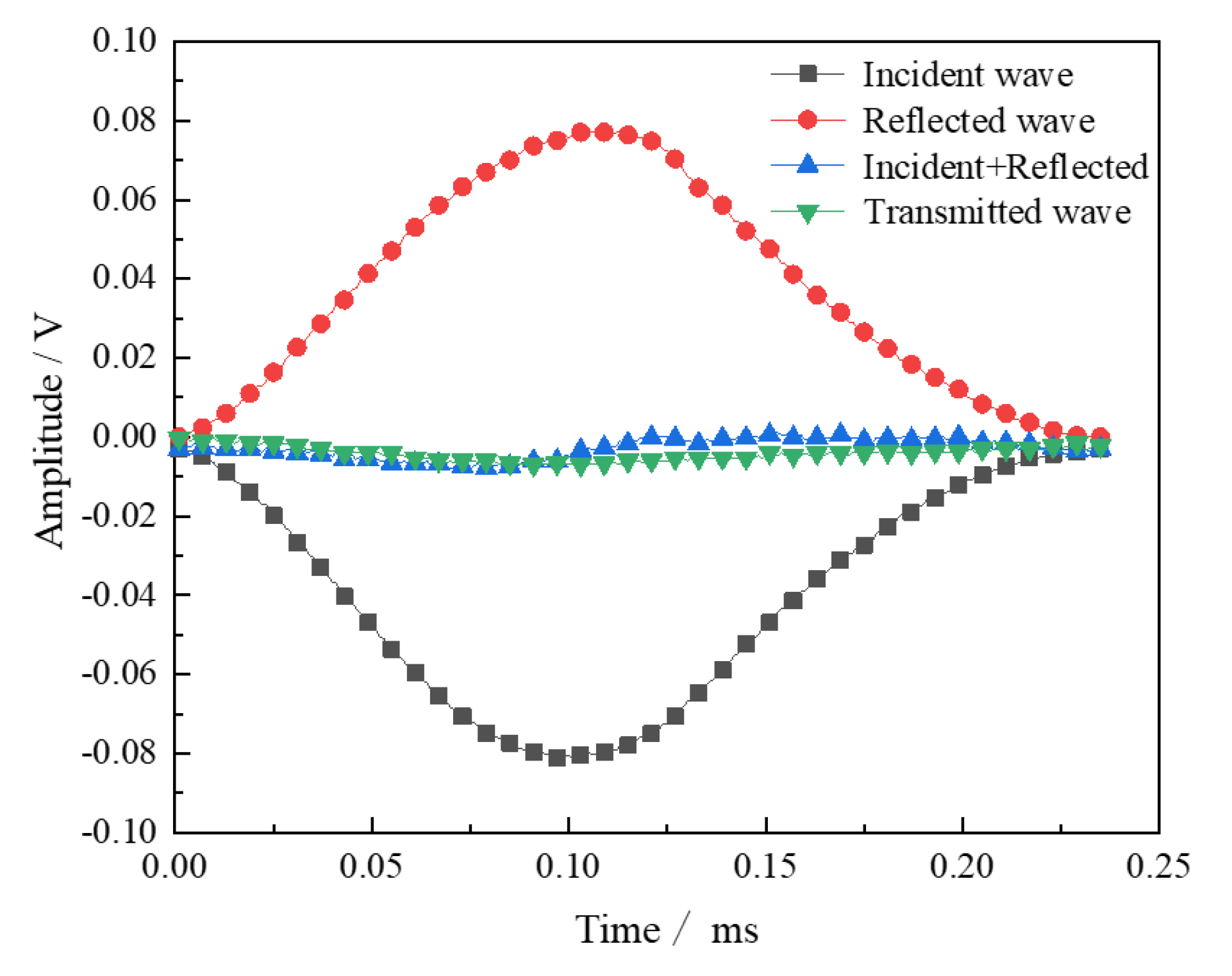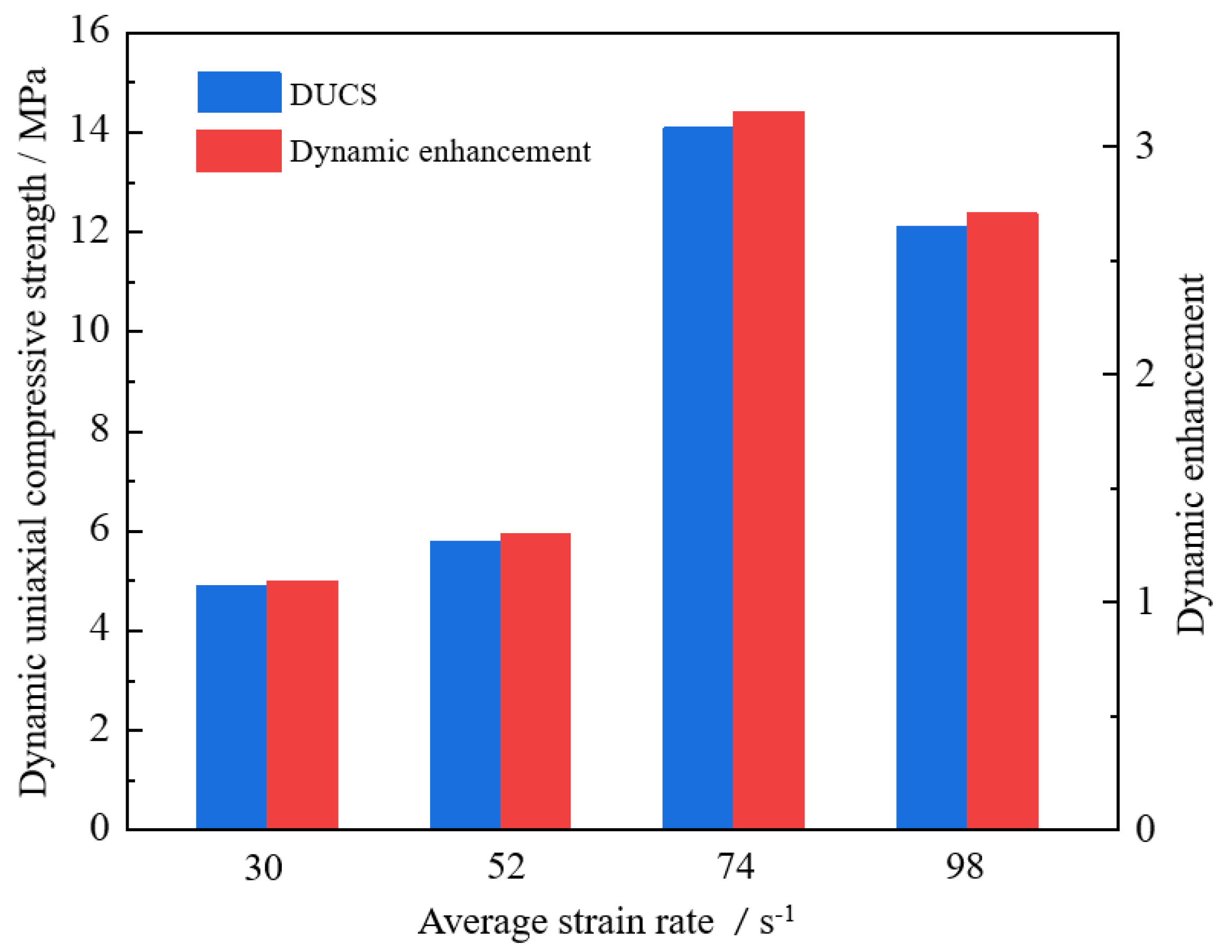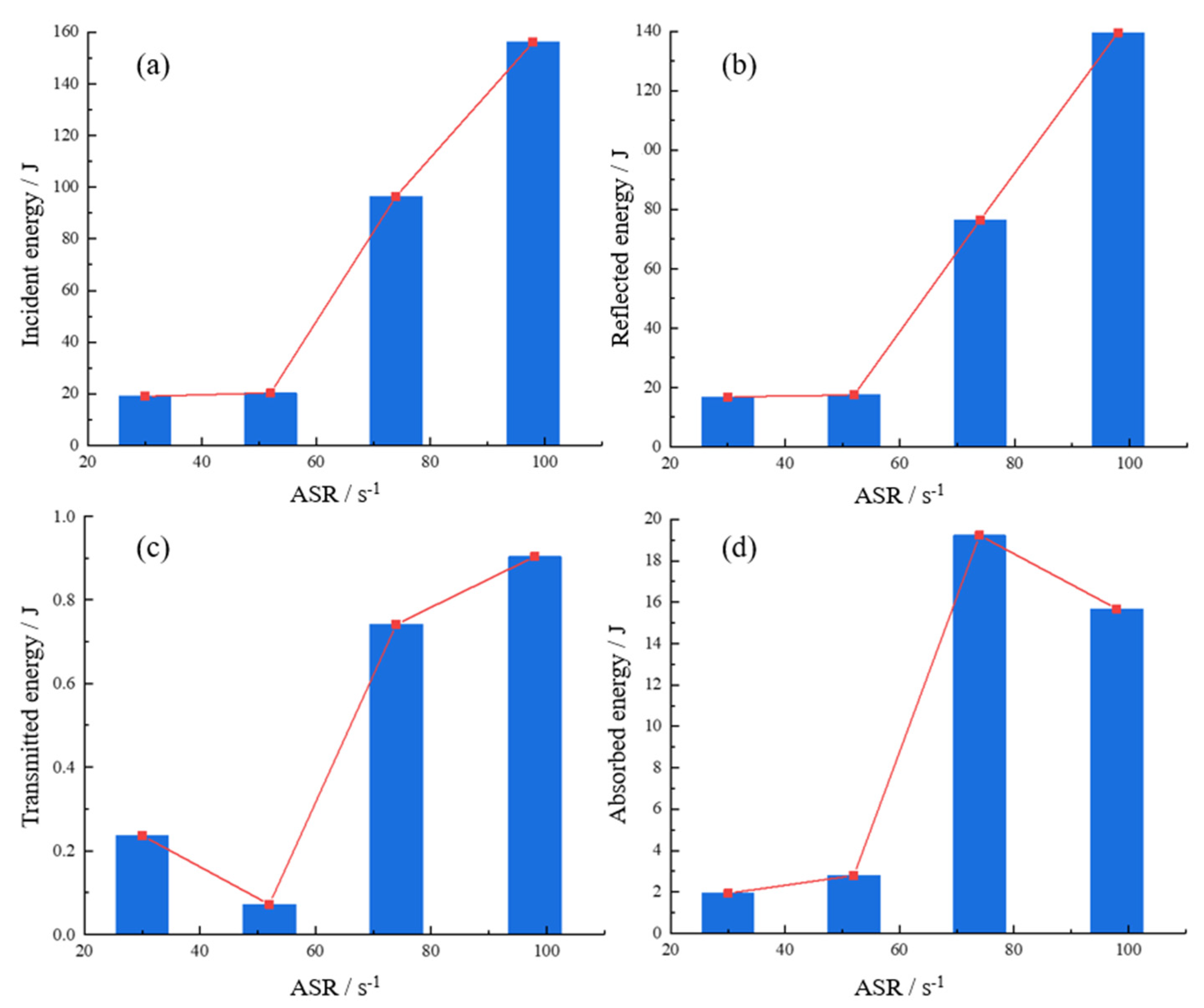Investigation on Dynamical Mechanics, Energy Dissipation, and Microstructural Characteristics of Cemented Tailings Backfill under SHPB Tests
Abstract
:1. Introduction
2. Materials and Methods
2.1. Material Characterization
2.2. Specimen Preparation
2.3. Experimental Devices
3. Results and Discussion
3.1. Dynamic Stress Equilibrium
3.2. Relation between Dynamic Stress and Strain
3.3. Energy Dissipation Analysis
3.4. Two-Dimensional Micros-Crack Distribution of CTB Specimens
3.5. Failure Modes of CTB Specimens Analysis
4. Conclusions
- (1)
- In the SHPB test, the superimposed wave of the incident wave and reflected wave was almost equal to the amplitude of the transmitted wave, and the waveforms overlapped. The two ends of the CTB specimen in this experiment reached a stressed equilibrium.
- (2)
- When the ASR is 30–98 s−1, with the increase in the ASR, the DUCS of the CTB shows a trend of first increasing and then decreasing.
- (3)
- The CTB also exhibits a strengthening effect of strain rate, and when the ASR is greater than 74 s−1, the strengthening effect decreases.
- (4)
- As the ASR increases, the incident energy of the CTB increases, and the reflected energy also increases. The transmitted energy can be negligible, and the absorbed energy shows a trend of first increasing and then decreasing, which is consistent with its dynamic peak intensity.
- (5)
- The pseudo-color enhancement was carried out for the original CT slice image with micro-CT. Results show that the closer the specimen near the incident bar, the larger the crack area of the specimen. The crack area ratio is exponentially related to the specimen height.
Author Contributions
Funding
Data Availability Statement
Acknowledgments
Conflicts of Interest
References
- Qin, J.; Zheng, J.; Li, L. Experimental study of the shrinkage behavior of cemented paste backfill. J. Rock Mech. Geotech. Eng. 2021. [Google Scholar] [CrossRef]
- Keita, A.M.T.; Jahanbakhshzadeh, A.; Li, L. Numerical analysis of the stability of arched sill mats made of cemented backfill. Int. J. Rock Mech. Min. 2021, 140, 104667. [Google Scholar] [CrossRef]
- Jiang, L.; Su, Y.; Dai, Q. Dynamic response mechanisms of layered cemented backfill pillars under horizontal stress wave disturbance of far-field blasting. Chin. J. Rock Mech. Eng. 2020, 39. [Google Scholar] [CrossRef]
- Wu, D.; Zhao, R.; Xie, C.; Liu, S. Effect of curing humidity on performance of cemented paste backfill. Int. J. Miner. Metall. Mater. 2020, 27, 1046–1053. [Google Scholar] [CrossRef]
- Zhang, J.; Deng, H.; Taheri, A.; Deng, J.; Ke, B. Effects of Superplasticizer on the Hydration, Consistency, and Strength Development of Cemented Paste Backfill. Minerals 2018, 8, 381. [Google Scholar] [CrossRef] [Green Version]
- Tang, Y.; Zheng, J.; Guo, L.; Zhao, Y. Effect of Gypsum Addition on the Mechanical and Microstructural Performance of Sulphide-Rich Cemented Paste Backfill. Minerals 2021, 11, 283. [Google Scholar] [CrossRef]
- Wang, J.; Fu, J.; Song, W.; Zhang, Y. Viscosity and Strength Properties of Cemented Tailings Backfill with Fly Ash and Its Strength Predicted. Minerals 2021, 11, 78. [Google Scholar] [CrossRef]
- Xu, W.; Cao, P.; Tian, M. Strength Development and Microstructure Evolution of Cemented Tailings Backfill Containing Different Binder Types and Contents. Minerals 2018, 8, 167. [Google Scholar] [CrossRef] [Green Version]
- Wu, J.; Feng, M.; Chen, Z.; Mao, X.; Han, G.; Wang, Y. Particle Size Distribution Effects on the Strength Characteristic of Cemented Paste Backfill. Minerals 2018, 8, 322. [Google Scholar] [CrossRef] [Green Version]
- Cao, S.; Yilmaz, E.; Song, W. Dynamic response of cement-tailings matrix composites under SHPB compression load. Constr. Build. Mater. 2018, 186, 892–903. [Google Scholar] [CrossRef]
- Cao, S.; Yilmaz, E.; Song, W. Evaluation of Viscosity, Strength and Microstructural Properties of Cemented Tailings Backfill. Minerals 2018, 8, 352. [Google Scholar] [CrossRef] [Green Version]
- Zhu, P.; Song, W.; Xu, L.; Wang, J.; Wan, F. A study on mechanical properties of cemented backfills under impact compressive loading. J. Vib. Shock. 2018, 37, 131–137. [Google Scholar]
- Tan, Y.; Wang, J.; Song, W.; Xu, L.; Cao, S. Experimental study on mechanical properties of cemented tailings backfill under cycle dynamic loading test. J. Min. Saf. Eng. 2019, 36, 184–190. [Google Scholar]
- Tan, Y.; Yu, X.; Elmo, D.; Xu, L.; Song, W. Experimental study on dynamic mechanical property of cemented tailings backfill under SHPB impact loading. Int. J. Miner. Metall. Mater. 2019, 26, 404–416. [Google Scholar] [CrossRef]
- Tan, Y.; Davide, E.; Zhou, Y.; Song, W.; Meng, X. Long-term mechanical behavior and characteristics of cemented tailings backfill through impact loading. Int. J. Miner. Metall. Mater. 2020, 27, 140–151. [Google Scholar] [CrossRef]
- Yang, W.; Tao, M.; Li, X.; Li, G. Mechanical Properties of the Total Tailing Cemented Backfilling Impacted by Cement-Sand Ratio Under High Strain Rate. J. Northeast. Univ. Nat. Sci. 2017, 38, 1659–1663. [Google Scholar]
- Yang, W.; Zhang, Q.; Yang, S.; Wang, X. Mechanical property of high concentration total tailing cemented backfilling under dynamic loading. J. Cent. South Univ. Sci. Technol. 2017, 48, 156–161. [Google Scholar]
- Wang, J.; Fu, Y.; Hou, Y.; Yang, M.; Zhang, J. Research on the Dynamic Load Impact Damage of Tailings Filling Bodies with Different Mixture Ratios. Min. Res. Dev. 2017, 37, 8–13. [Google Scholar]
- Yang, Q. Experimental Study on Mechanical Properties of Cemented Backfill under Impact. Mod. Min. 2019, 35, 84–86. [Google Scholar]
- Cao, S.; Yilmaz, E.; Song, W.; Yilmaz, E.; Xue, G. Loading rate effect on uniaxial compressive strength behavior and acoustic emission properties of cemented tailings backfill. Constr. Build. Mater. 2019, 213, 313–324. [Google Scholar] [CrossRef]
- Zhang, Y.; Wang, X.; Wei, C.; Zhang, Q. Dynamic mechanical properties and instability behavior of layered backfill under intermediate strain rates. T. Nonferr. Metal. Soc. 2017, 27, 1608–1617. [Google Scholar] [CrossRef]
- Zhang, Q.; Yang, W.; Yang, S.; Wang, X. Test research on the stability of high-density total tailing cemented backfilling under dynamic loading. China Saf. Sci. J. 2015, 25, 78–82. [Google Scholar]
- Yin, S.; Chen, X.; Yan, R.; Wang, L. Pore Structure Characterization of Undisturbed Weathered Crust Elution-Deposited Rare Earth Ore Based on X-ray Micro-CT Scanning. Minerals 2021, 11, 236. [Google Scholar] [CrossRef]
- Sun, W.; Wu, A.; Hou, K.; Yang, Y.; Liu, L.; Wen, Y. Real-time observation of meso-fracture process in backfill body during mine subsidence using X-ray CT under uniaxial compressive conditions. Constr. Build. Mater. 2016, 113, 153–162. [Google Scholar] [CrossRef]
- Sun, W.; Hou, K.; Yang, Z.; Wen, Y. X-ray CT three-dimensional reconstruction and discrete element analysis of the cement paste backfill pore structure under uniaxial compression. Constr. Build. Mater. 2017, 138, 69–78. [Google Scholar] [CrossRef]
- Wang, J.; Fu, J.; Song, W. Mechanical properties and microstructure of layered cemented paste backfill under triaxial cyclic loading and unloading. Constr. Build. Mater. 2020, 257, 119540. [Google Scholar] [CrossRef]
- Cao, S.; Yilmaz, E.; Yin, Z.; Xue, G.; Song, W.; Sun, L. CT scanning of internal crack mechanism and strength behavior of cement-fiber tailings matrix composites. Cem. Concr. Compos. 2020. [Google Scholar] [CrossRef]
- Xue, G.; Yilmaz, E.; Song, W.; Cao, S. Analysis of internal structure behavior of fiber reinforced cement-tailings matrix composites through X-ray computed tomography. Compos. Part B 2019, 175, 107091. [Google Scholar] [CrossRef]
- Yi, X.; Liu, C.; Wang, Y. Experimental study on the fracture evolution of cemented waste rock-tailings backfill (CWRB) of metal ore using in-situ CT scanning. Rock Soil Mech. 2020, 41, 3365–3373. [Google Scholar]
- Yang, L.; Xu, W.; Yilmaz, E.; Wang, Q.; Qiu, J. A combined experimental and numerical study on the triaxial and dynamic compression behavior of cemented tailings backfill. Eng. Struct. 2020, 219, 110957. [Google Scholar] [CrossRef]
- Hao, Y.; Hao, H. Numerical Investigation of the Dynamic Compressive Behaviour of Rock Materials at High Strain Rate. Rock Mech. Rock Eng. 2013, 46, 373–388. [Google Scholar] [CrossRef]
- Zhang, S.; Yang, L.; Ren, F.; Qiu, J.; Ding, H. Rheological and mechanical properties of cemented foam backfill: Effect of mineral admixture type and dosage. Cem. Concr. Compos. 2020, 112, 103689. [Google Scholar] [CrossRef]
- Huang, Z.; Yilmaz, E.; Cao, S. Analysis of Strength and Microstructural Characteristics of Mine Backfills Containing Fly Ash and Desulfurized Gypsum. Minerals 2021, 11, 409. [Google Scholar] [CrossRef]
- Gerges, N.N.; Issa, C.A.; Fawaz, S. Effect of construction joints on the splitting tensile strength of concrete. Case Stud. Constr. Mater. 2015, 3, 83–91. [Google Scholar] [CrossRef] [Green Version]
- Xue, G.; Yilmaz, E.; Song, W.; Cao, S. Compressive Strength Characteristics of Cemented Tailings Backfill with Alkali-Activated Slag. Appl. Sci. 2018, 8, 1537. [Google Scholar] [CrossRef] [Green Version]
- Xue, G.; Yilmaz, E.; Feng, G.; Cao, S.; Sun, L. Reinforcement effect of polypropylene fiber on dynamic properties of cemented tailings backfill under SHPB impact loading. Constr. Build. Mater. 2021, 279, 122417. [Google Scholar] [CrossRef]
- Liu, Z.; Gan, D.; Gan, Z. Dynamic regimes of cemented backfill at early-age. J. Cent. South Univ. 2021, 1–13. Available online: http://kns.cnki.net/kcms/detail/43.1516.TB.20210308.1618.016.html (accessed on 24 April 2021).
- Qiu, J.; Li, D.; Li, X. Dynamic failure of a phyllite with a low degree of metamorphism under impact Brazilian test. Int. J. Rock Mech. Min. 2017, 94, 10–17. [Google Scholar] [CrossRef]
- Gong, F.; Wang, J.; Li, X. The rate effect of compression characteristics and a unified model of the dynamic increasing factor for rock materials. Chin. J. Rock mech. Eng. 2018, 37, 1586–1595. [Google Scholar]
- Chen, X.; Shi, X.; Zhou, J.; Li, E.; Qiu, P.; Gou, Y. High strain rate compressive strength behavior of cemented paste backfill using split Hopkinson pressure bar. Int. J. Min. Sci. Technol. 2021. [Google Scholar] [CrossRef]
- Cao, S.; Zheng, D.; Yilmaz, E.; Yin, Z.; Xue, G.; Yang, F. Strength development and microstructure characteristic of artificial concrete pillar considering fiber type and content effects. Constr. Build. Mater. 2020, 256, 119408. [Google Scholar] [CrossRef]











| Chemical Composition | SiO2 | Al2O3 | K2O | CaO | Fe2O3 | SO3 | MnO |
|---|---|---|---|---|---|---|---|
| Content (wt.%) | 58.4 | 7.03 | 4.02 | 2.08 | 1.29 | 0.7 | 0.041 |
| Chemical Composition | CaO | SiO2 | SO3 | Al2O3 | Fe2O3 | TiO2 | K2O | MnO |
|---|---|---|---|---|---|---|---|---|
| Content (wt.%) | 35.4 | 17.1 | 3.21 | 2.39 | 2.19 | 0.56 | 0.44 | 0.1 |
| Specimen No. | ASR | ||||
|---|---|---|---|---|---|
| 1 | 30 | 18.99 | 16.82 | 0.24 | 1.93 |
| 2 | 52 | 20.34 | 17.47 | 0.07 | 2.79 |
| 3 | 74 | 96.46 | 76.49 | 0.74 | 19.23 |
| 4 | 98 | 156.22 | 139.64 | 0.90 | 15.68 |
| ASR/s−1 | 30 | 52 | 74 | 98 |
|---|---|---|---|---|
 |  |  |  | |
 |  |  |  |
Publisher’s Note: MDPI stays neutral with regard to jurisdictional claims in published maps and institutional affiliations. |
© 2021 by the authors. Licensee MDPI, Basel, Switzerland. This article is an open access article distributed under the terms and conditions of the Creative Commons Attribution (CC BY) license (https://creativecommons.org/licenses/by/4.0/).
Share and Cite
Zheng, D.; Song, W.; Cao, S.; Li, J.; Sun, L. Investigation on Dynamical Mechanics, Energy Dissipation, and Microstructural Characteristics of Cemented Tailings Backfill under SHPB Tests. Minerals 2021, 11, 542. https://0-doi-org.brum.beds.ac.uk/10.3390/min11050542
Zheng D, Song W, Cao S, Li J, Sun L. Investigation on Dynamical Mechanics, Energy Dissipation, and Microstructural Characteristics of Cemented Tailings Backfill under SHPB Tests. Minerals. 2021; 11(5):542. https://0-doi-org.brum.beds.ac.uk/10.3390/min11050542
Chicago/Turabian StyleZheng, Di, Weidong Song, Shuai Cao, Jiajian Li, and Lijuan Sun. 2021. "Investigation on Dynamical Mechanics, Energy Dissipation, and Microstructural Characteristics of Cemented Tailings Backfill under SHPB Tests" Minerals 11, no. 5: 542. https://0-doi-org.brum.beds.ac.uk/10.3390/min11050542







